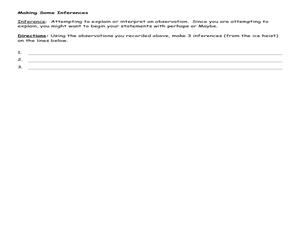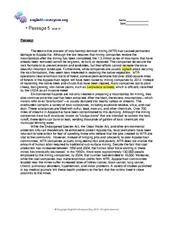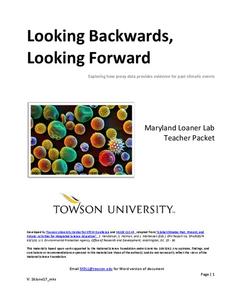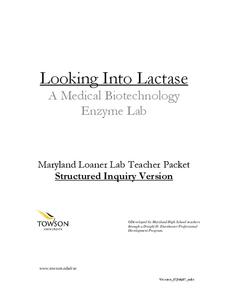Curated OER
Observation and Inference
Assess your young scientists' understanding of the difference between observation and inference with this 20-question multiple choice quiz. It reviews a variety of physics and astronomy concepts, such as solar eclipses and sunspots, the...
Curated OER
Inferences: An Experiment with Ice
In this inferences: an experiment with ice learning exercise, students follow the procedure for the experiment with ice, then write inferences from their observations.
Curated OER
Making Inferences: Scenario Worksheet
In this making inferences worksheet, learners read 5 statements and they write what they can infer about each statement. Students make their own inference scenario and identify what they can infer from their scenario.
Curated OER
Pop Rock Chemistry
In this pop rock chemistry worksheet, learners suck on pop rocks, they mix open pop rocks with water and they observe them on a paper towel with water. Students write down as many observations as they can and they write down as many...
Curated OER
Qualitative and Quantitative Observations
In this qualitative and quantitative observation learning exercise, students determine if 10 given observations are quantitative or qualitative. They write a qualitative and quantitative statement and they write an observation and...
Curated OER
The Scientific Method
In this scientific method activity, students complete a crossword puzzle given 21 clues about the steps of the scientific method. Topics include observations, hypotheses, variables, inferences, results and conclusions.
Curated OER
Egg In a Bottle
In this scientific investigation worksheet, students observe a demonstration where paper is ignited and placed in a bottle with a hard-boiled egg at the opening. Students predict what will occur, they make observations and they make...
Curated OER
Reading Comprehension 5: Level 10
Whether used as a reading comprehension assessment, as the basis of a mini-lesson on reading strategies, or as extra practice, this exercise will prove to be valuable because of the answers and explanation key that accompanies the...
Curated OER
Process Skills Review: Observation, Inference, and Predictions
A simple worksheet asks science learners to define five terms and identify five statements as predictions, observations, or inferences. This would be a supportive assignment when introducing elementary-levle scientist to inquiry practices.
Curated OER
Organizer for Fact Finding and Inferring from Visual Sources
In this graphic organizer fact finding and inferences worksheet, students record details that they can see and prove as well as those that are inferences.
Curated OER
The Milk Bottle Quiz
In this scientific statements worksheet, pupils identify statements as an observation, inference, question, prediction, or factual. This worksheet has 7 matching questions.
Curated OER
Scientific Method
In this science instructional activity, students identify and locate each of the words to the right in the word search puzzle on the left. Then they list as many words as they can from the letters in scientific method.
Towson University
Looking Into Lactase: Guided Inquiry
Milk does a body good ... unless, of course, someone is lactose intolerant. Pupils play the role of pharmaceutical scientists in a guided inquiry lab about lactase. Lab groups collaborate to learn more about lactose intolerance, how...
Creative Chemistry
The Effect of Concentration Changes on Equilibrium
In this concentration changes and equilibrium activity, learners experiment with iron (III) ions and thiocyanate ions to observe the effects of concentration on the equilibrium of solutions. Students observe their mixtures, explain the...
Towson University
Looking Backwards, Looking Forward
How do scientists know what Earth's climate was like millions of years ago? Young environmental scholars discover how researchers used proxy data to determine the conditions present before written record. Grouped pupils gain experience...
Towson University
Mystery Tubes
How do scientists know they're right? Truth be told, they don't always know. Explore the scientific process using mystery tubes in an insightful activity. Young scientists discover how to approach and solve problems in science, how ideas...
Towson University
Case of the Crown Jewels
Can your biology class crack the Case of the Crown Jewels? Junior forensics experts try their hands at DNA restriction analysis in an exciting lab activity. The lesson introduces the concept of restriction analysis, teaches pipetting and...
Towson University
Looking Into Lactase: Structured Inquiry
Why is lactase important? Biology scholars explore enzyme function in a structured inquiry lab. The activity tasks lab groups with observing how temperature and pH affect enzyme activity, as well as determining which milk products...
Towson University
The Wildlife Forensics Lab
Can science put an end to the poaching of endangered species? Show your young forensic experts how biotechnology can help save wildlife through an exciting electrophoresis lab. Grouped pupils analyze shark DNA to determine if it came...
Have Fun Teaching
Growing Seeds (9)
A seed, water, and sunlight. A seed, water, but no sunlight. A seed, sunlight, but no water. Young biologists are ask to infer what will happen to seeds given five different growing conditions.
Royal Society of Chemistry
Mass Changes in Chemical Reactions—Microscale Chemistry
What better way is there to introduce conservation of mass than a few simple experiments? Young chemists conduct two chemical reactions, take the masses of reactants and products, then compare their results to determine...
Creative Chemistry
The Chemical Detective
In this chemical detectives worksheet, students perform six tests on various unknown solutions, including a test for chloride ions, sulphate ions, carbonate ions, iron (III) ions, iron (II) ions, and copper (II) ions. Students record...
Curated OER
How Does A Plant Cell Relate To Your School?
In this biology worksheet, students chart and compare the observations made about a cell and the school building of a classroom. The inferences about cells are based upon textbook information.
Curated OER
Event Graphic Organizer
In this event graphic organizer activity, students identify an event, record details, list prior knowledge, make inferences, and make a conclusion.























